A co-parenting agreement template is a document that outlines the terms and conditions set by individuals who are not in a relationship but have shared custody of a child or children.
It typically addresses custody and visitation arrangements, communication strategies, decision-making authority, and financial responsibilities. The template provides a framework to outline each parent’s expectations, responsibilities, and rights. This helps minimize conflicts, establish clear communication lines, and ensure the overall well-being of the children.
For divorced, separated, or unmarried parents, using a template for a co-parenting agreement is beneficial as it helps promote cooperation and stability in the co-parenting relationship. It allows them to develop a co-parenting plan with the child’s best interests in mind. The agreement can be used as a reference for both parents, helping them navigate the complexities arising from shared custody of a child.
A formal co-parenting contract is vital for your child’s stability and emotional well-being. A written agreement ensures you and your co-partner are on the same page regarding the crucial aspects of co-parenting, allowing you to navigate your shared roles and responsibilities. It also serves as a reference point in the event of disagreements by providing conflict-resolution guidelines, reducing the likelihood of unnecessary arguments or legal battles.
A co-parenting agreement sets a proper routine for the child and helps maintain a sense of security, as they are aware of what to expect from each parent and the boundaries established by both. Addressing future considerations as the child grows older allows co-parents to plan for potential challenges and adapt to major life events or changes in circumstances. Since it is a legally enforceable document, one parent can seek legal remediation in court if the other parent fails to comply with its terms.
This article will highlight the importance of using a template for a co-parenting agreement, what it contains, and its various categories. Some frequently asked questions and legal considerations have also been addressed. For your convenience, free printable templates have also been provided in PDF format.
How a Template Can Help Establish Clear Expectations
The template presents you and your co-parent with a concise and consistent framework for co-parenting. It also helps agreement helps minimize conflicts and disagreements by addressing aspects such as communication, conflict resolution methods and decision-making authority. The template helps establish a consistent routine for your child regarding visitation, custody, or other crucial aspects of their lives, such as education or healthcare. It sets clear guidelines for joint decision-making by specifying the areas where the input of both parents is required.
The template can be modified to ensure the agreement accurately captures the aspects of your co-parenting situation. You can customize it to address the specific circumstances and unique requirements of your child. Using a template for a co-parenting agreement helps foster a smooth co-parenting experience for your child and minimizes the possibility of misunderstandings.
Free Templates
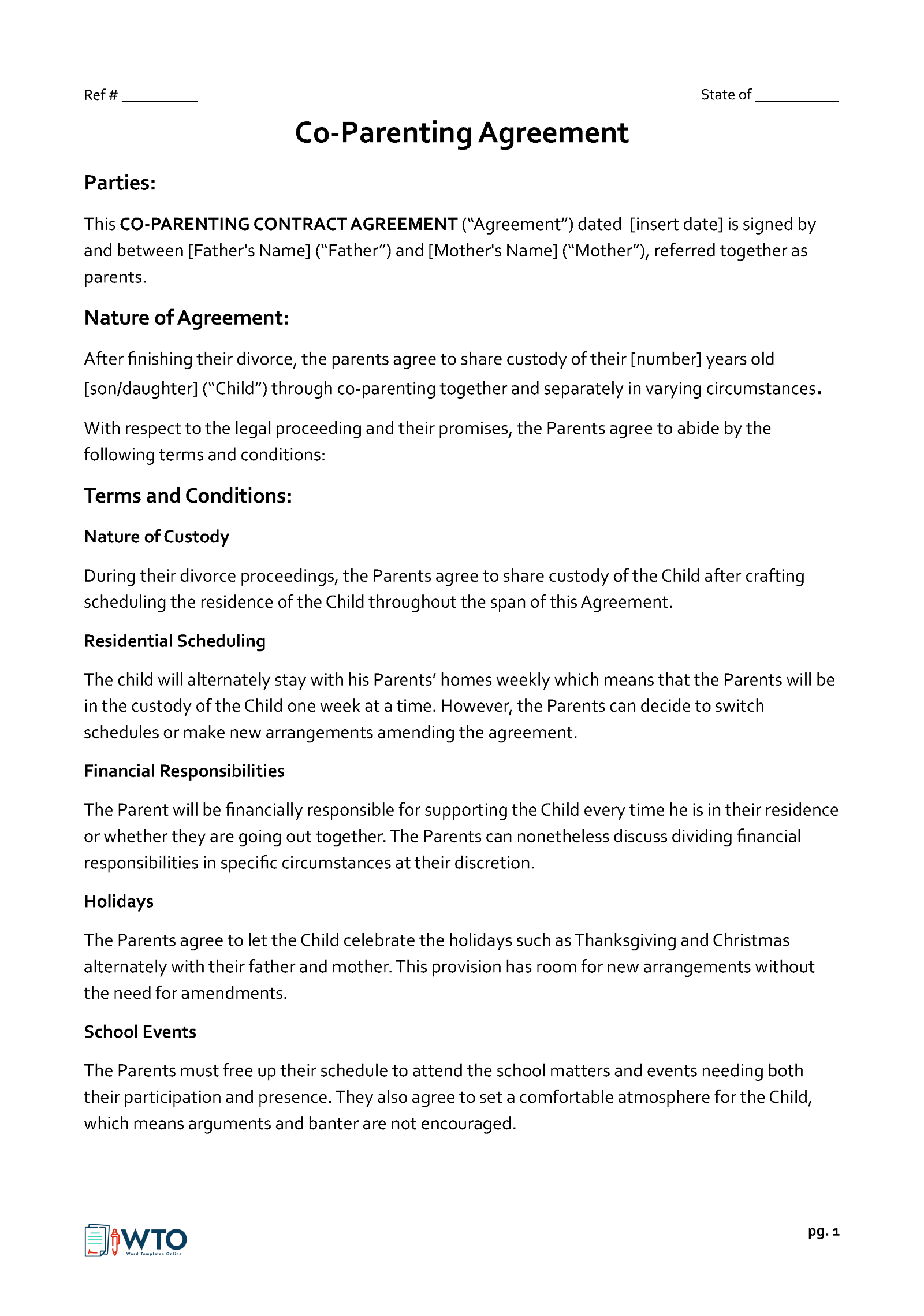
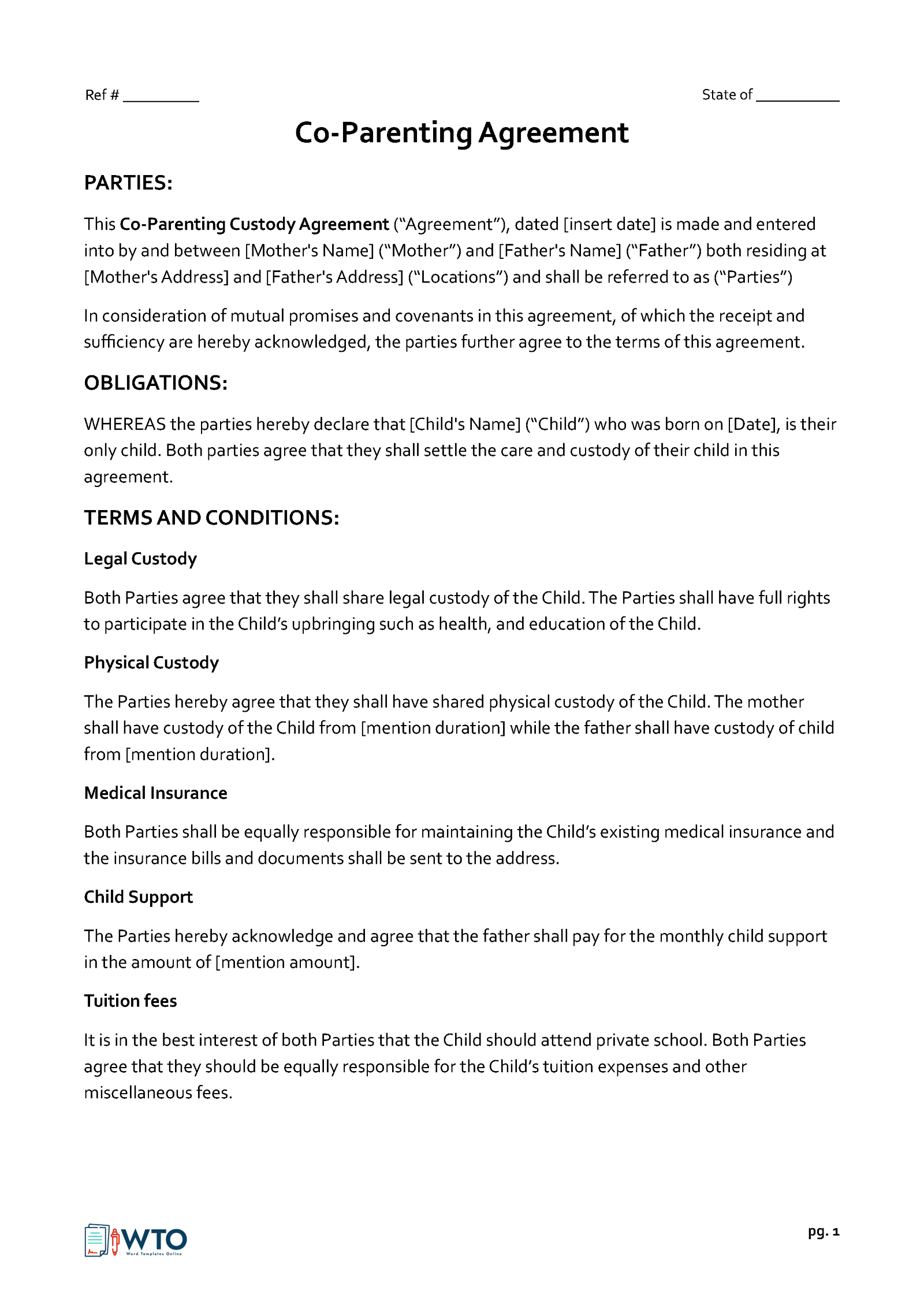
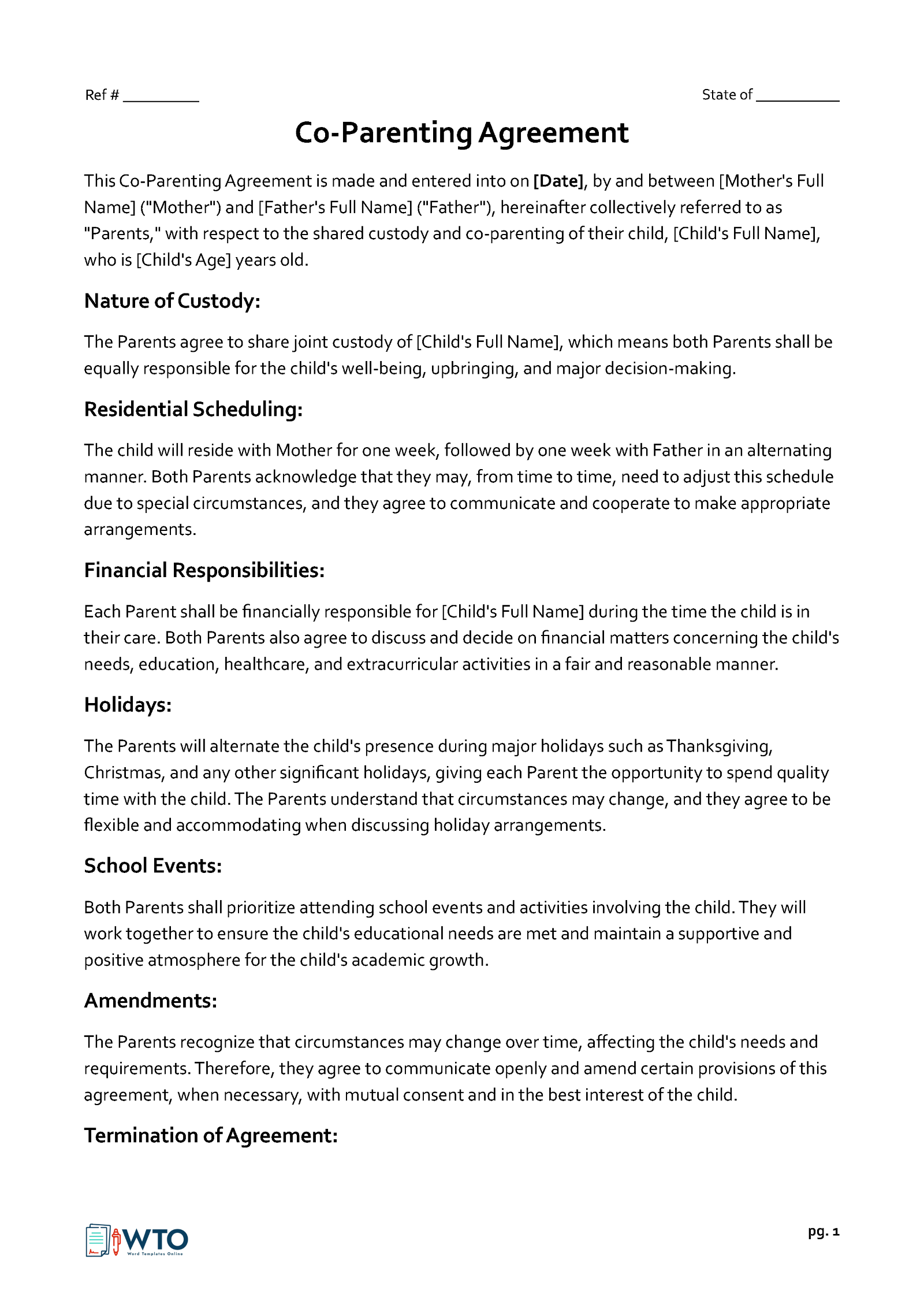
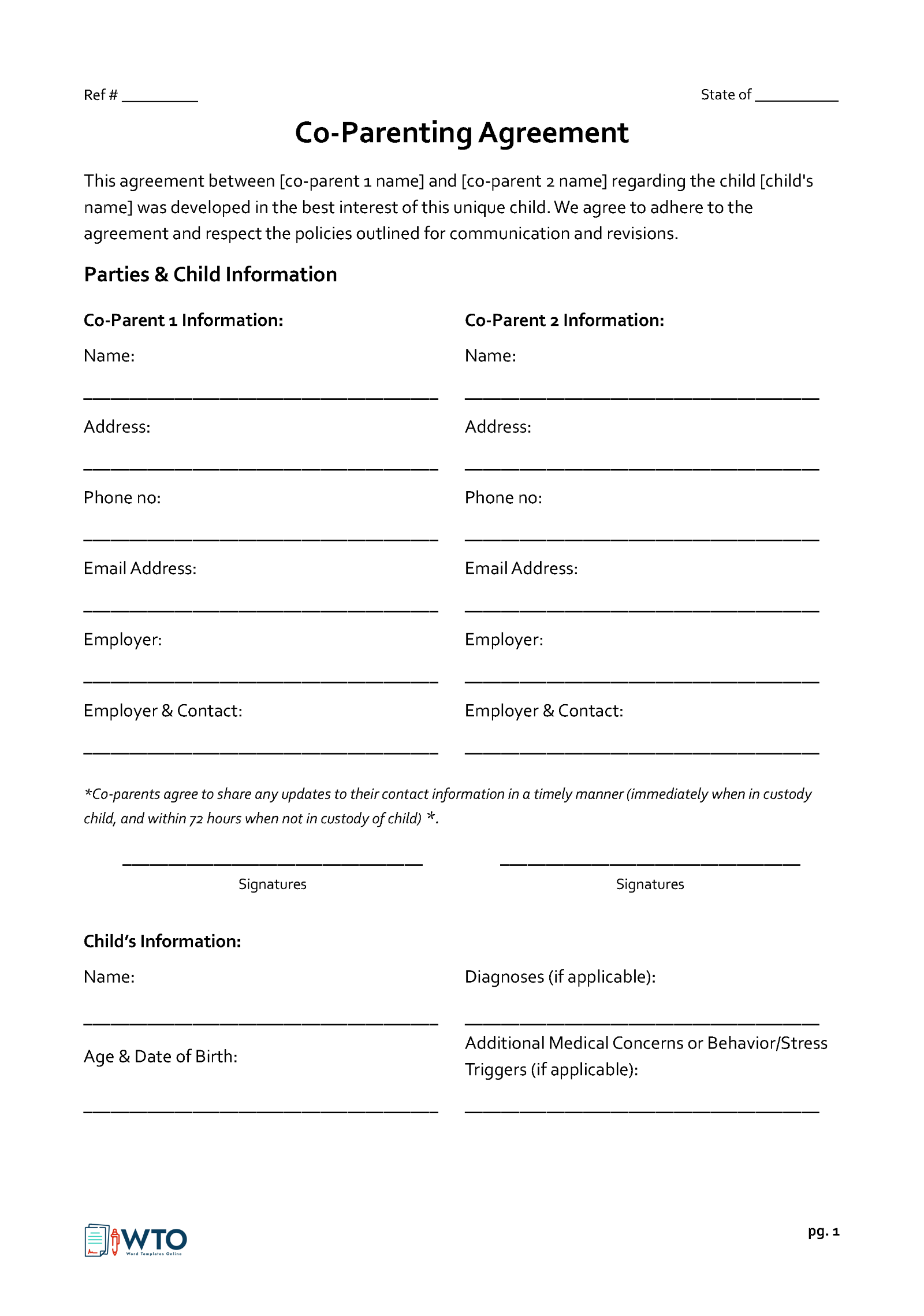
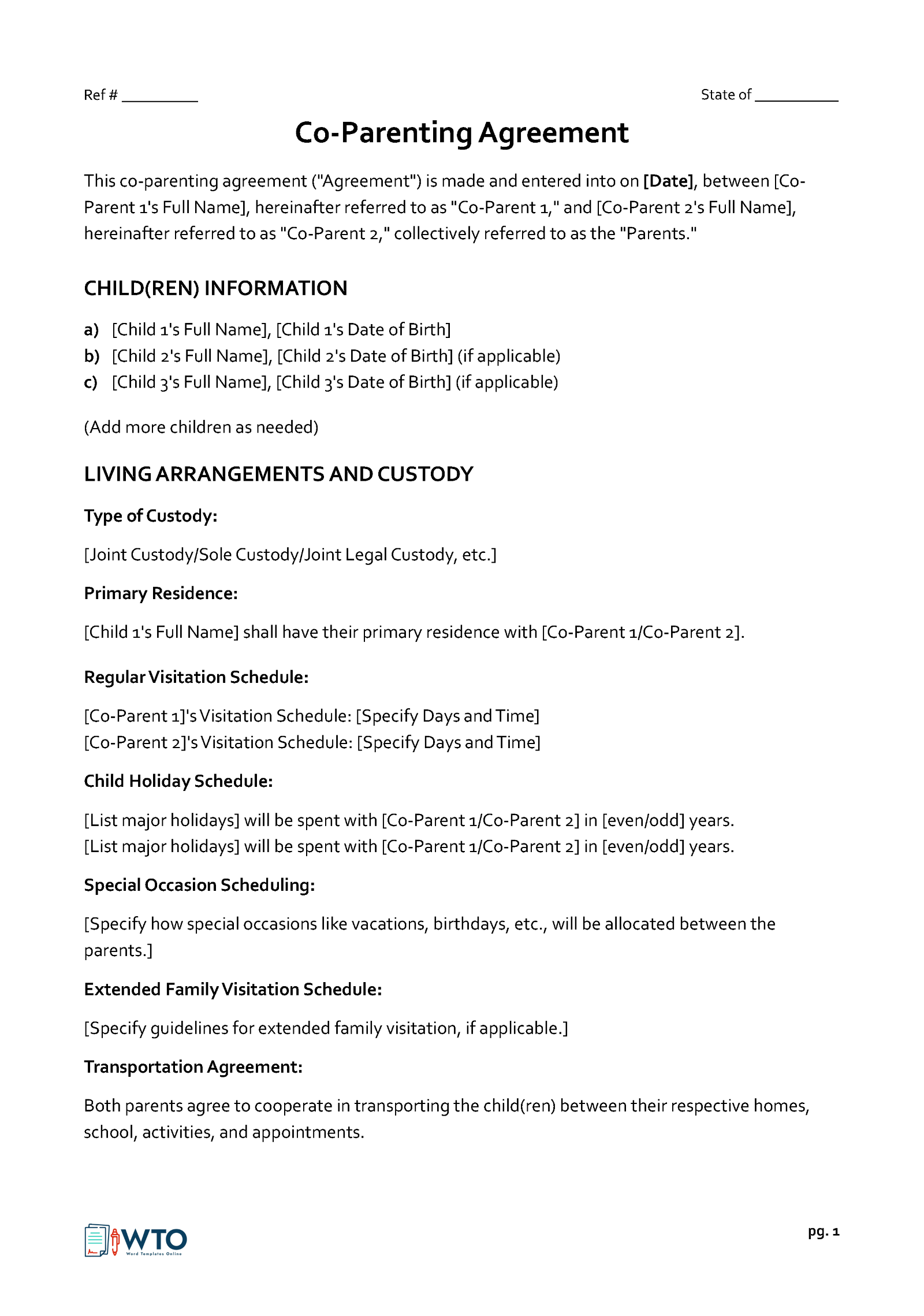
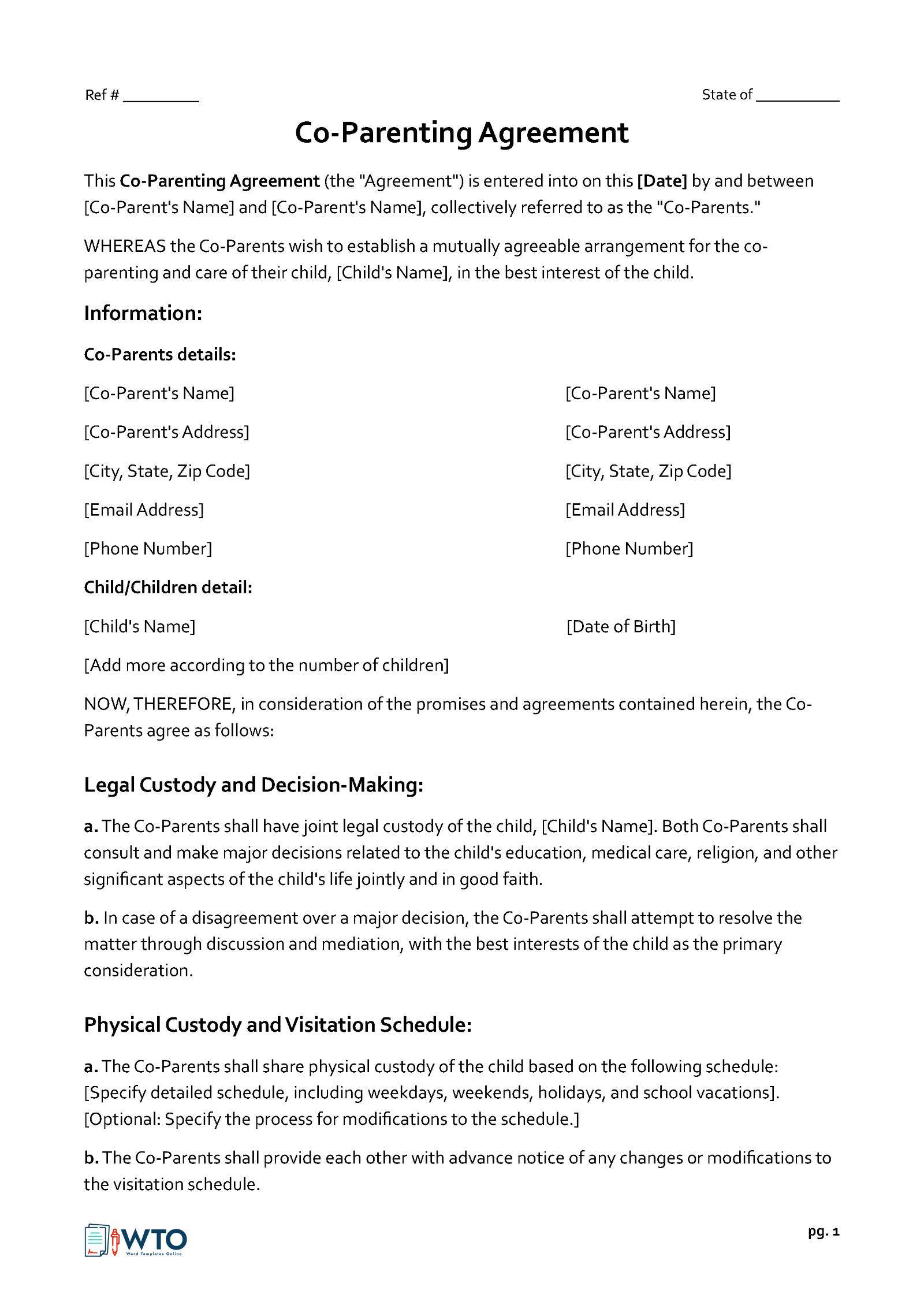
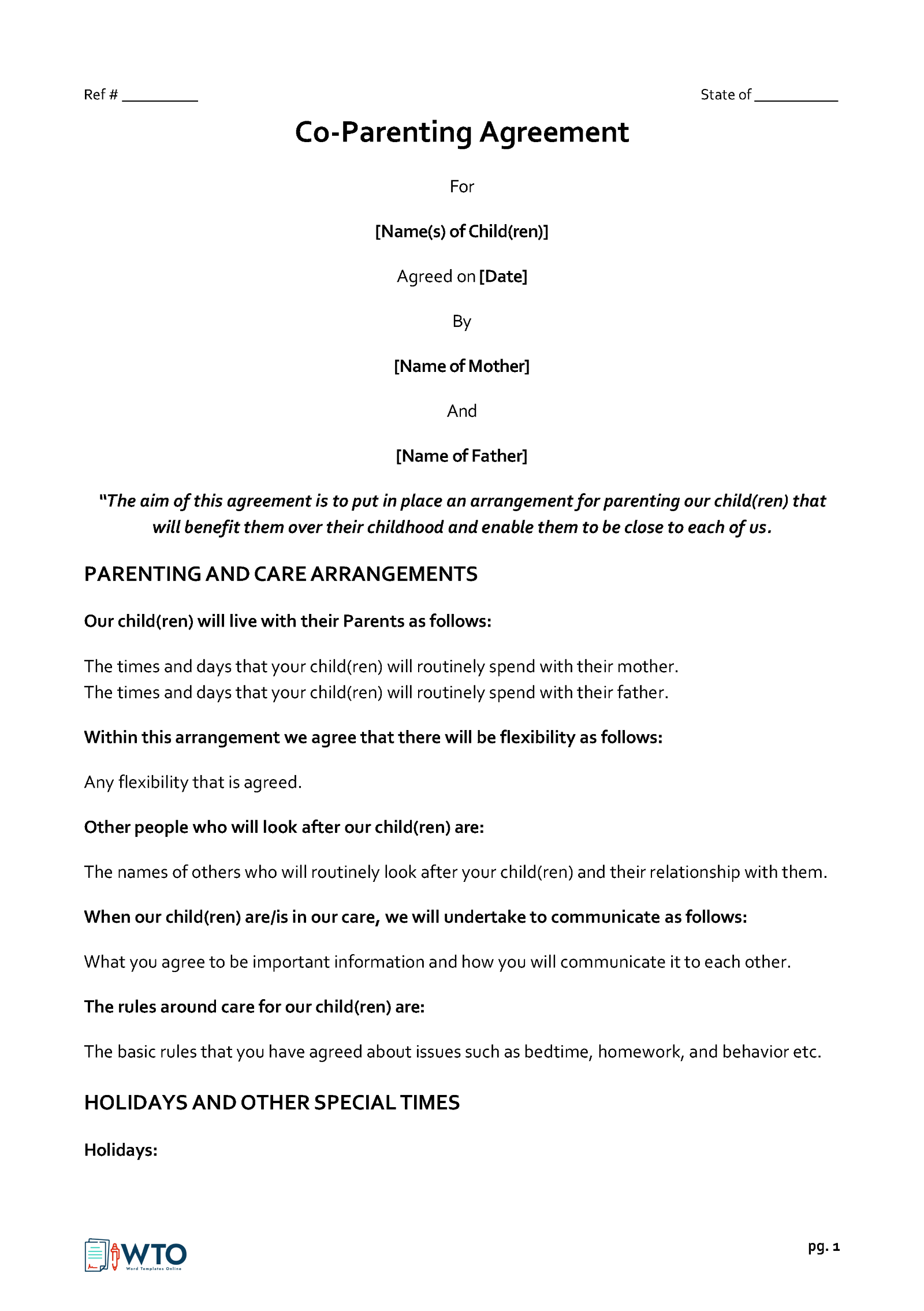
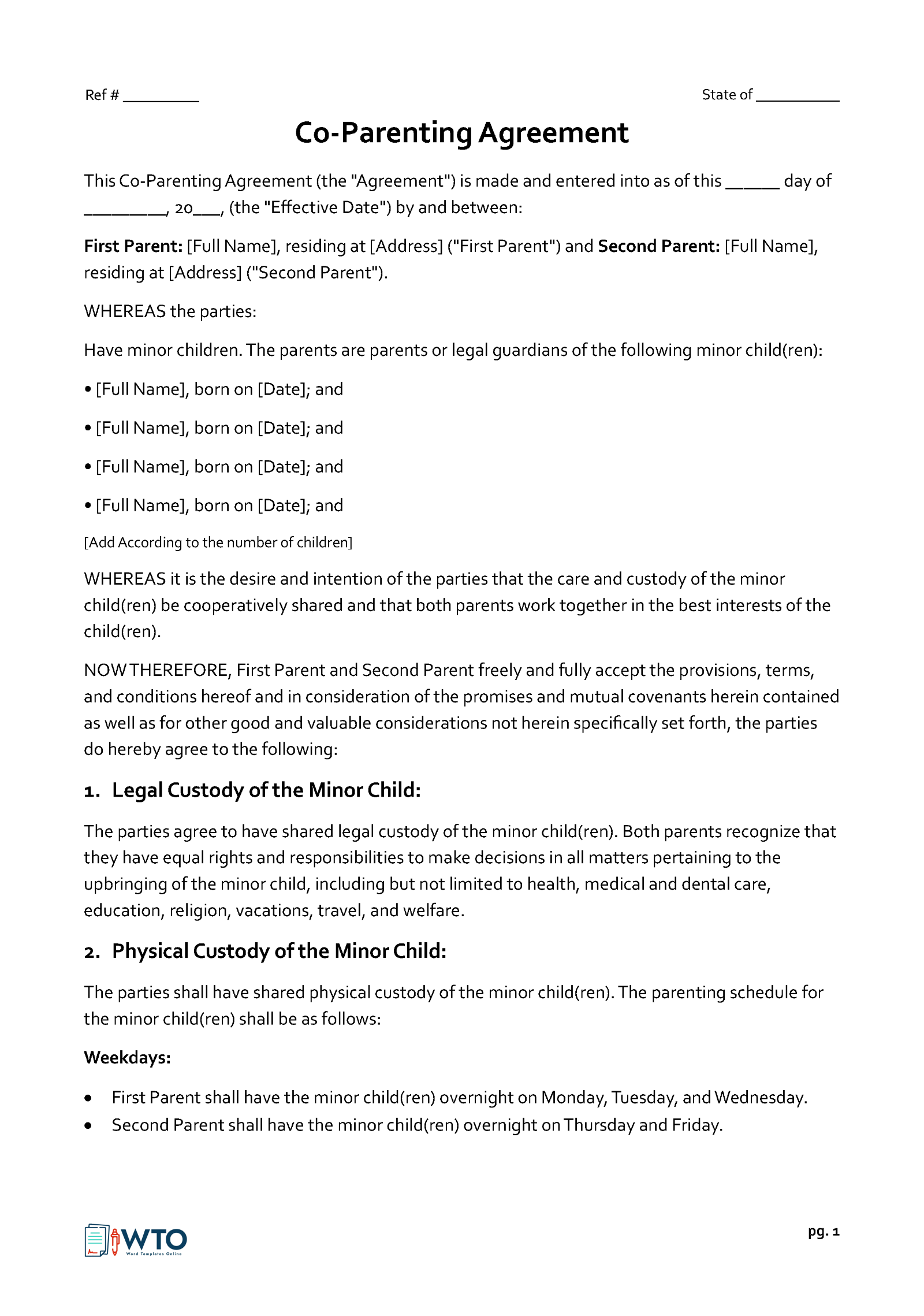
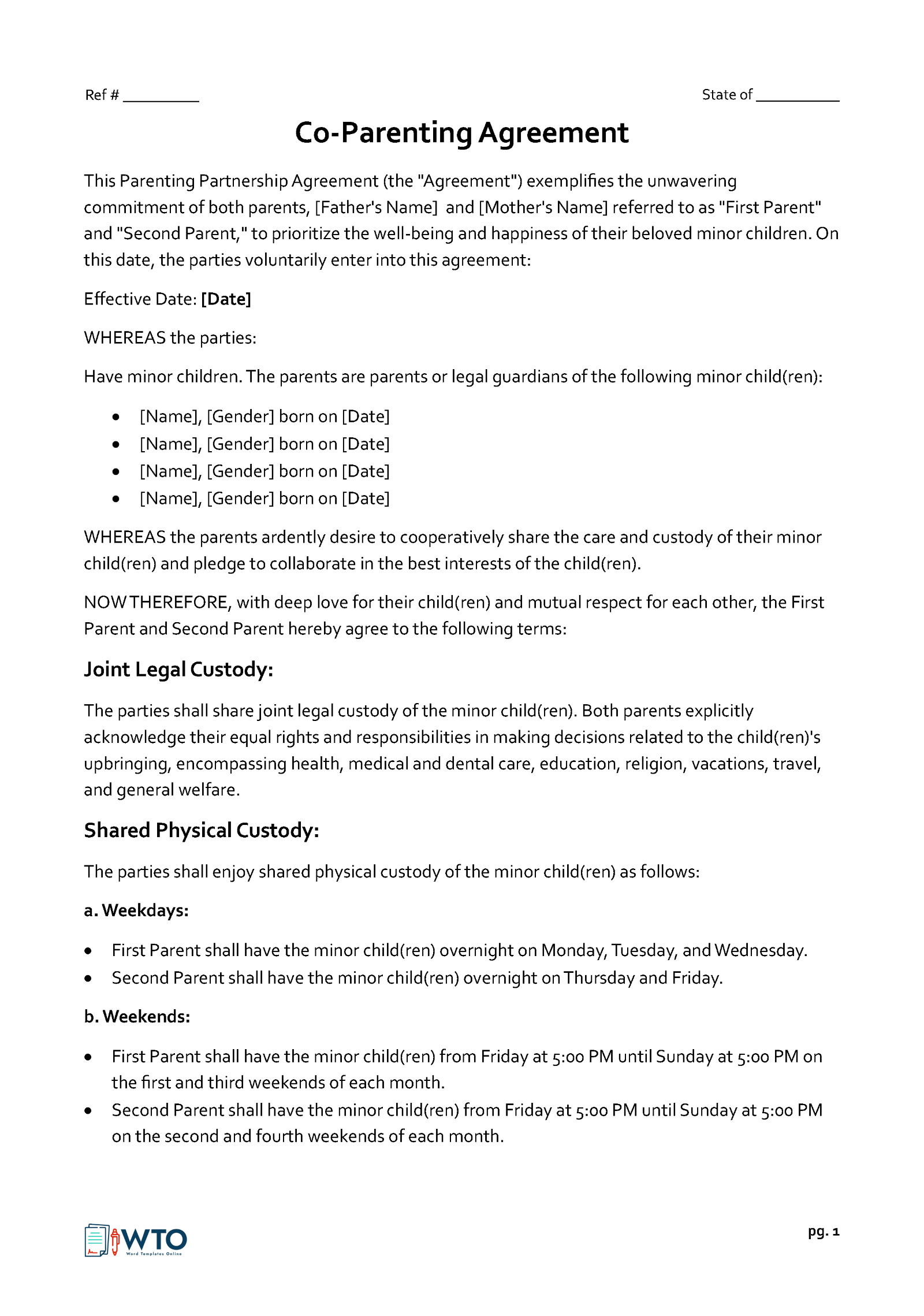
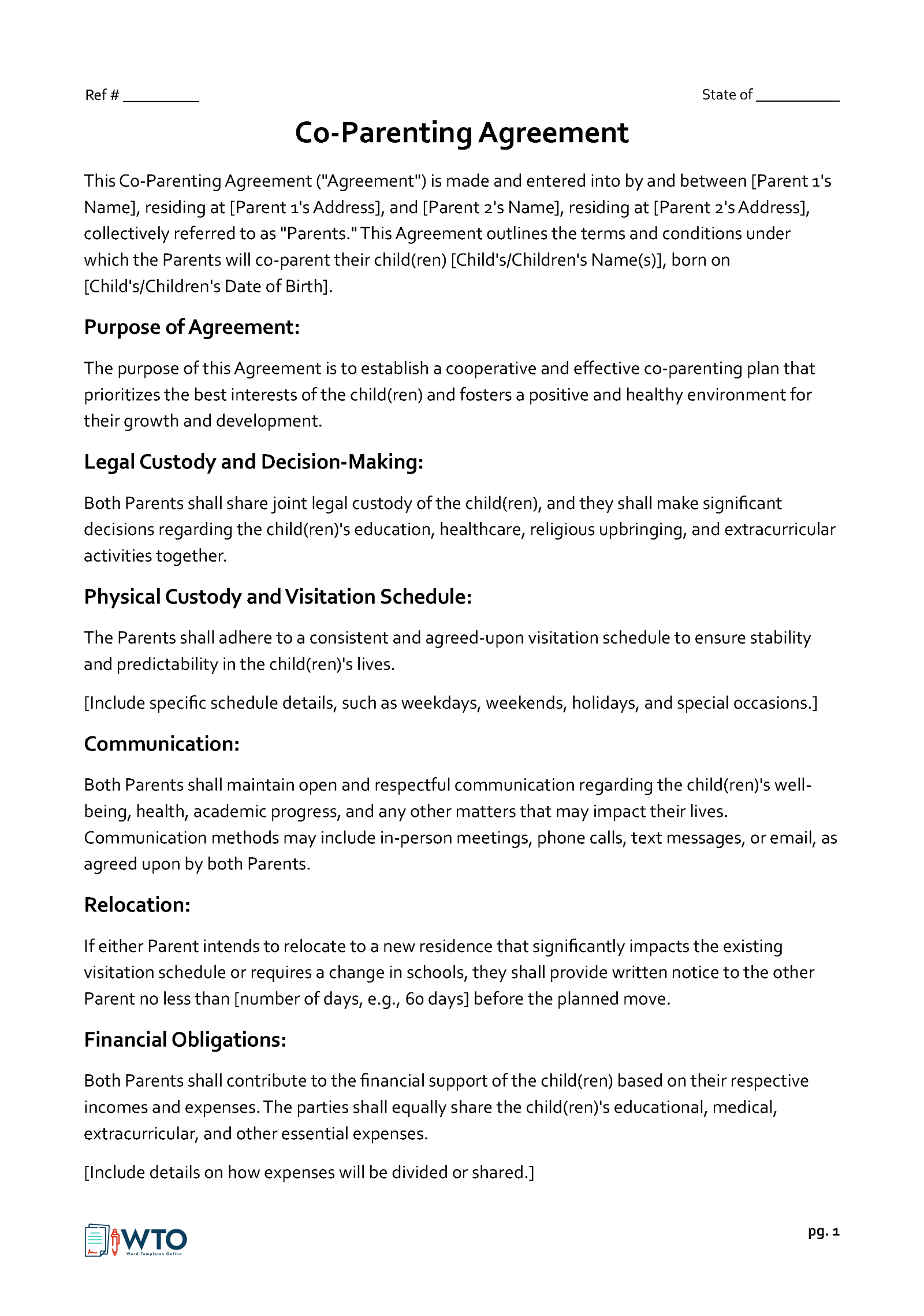
Information to be Included: A Step-by-Step Guide
A co-parenting plan aims to protect the interests of your child by providing structure and clarity about parenting responsibilities. Below is a step-by-step guide on what to include in the template:
Step 1: Parent and child information
The first step in filling the template is giving detailed information about yourself, your co-parent, and your child. Provide full names, physical addresses, and contact information. You may include your child’s date of birth and social security number for easy identification.
Step 2: Custody arrangements
Next, specify the type of agreed-upon custody arrangement that works best for you and your co-parent. Specify whether it is joint or sole physical custody or joint or sole legal custody. Mention where the child will reside and outline your decision-making authority.
Step 3: Parenting/visitation schedule
Provide a detailed schedule for parenting and visitation times that best work for you and your co-parent. Account for weekdays, weekends, overnight stays, or any other necessary variations. When outlining a visitation schedule in the template, consider your child’s age, school schedule, and developmental needs.
Step 4: Holiday, academic, and social activities
In this section, outline how you and your co-parent will share birthdays, holidays, and other important occasions. Develop a suitable arrangement for vacations, school breaks, and special events in your child’s life. You may alternate the years or timeframes one parent spends with the child to ensure consistency and fairness.
Step 5: Medical decisions & health insurance
Outline how you will make medical decisions for your child during routine health check-ups or emergencies. Specify your preferred insurance provider and their responsibility for health insurance coverage. Provide a detailed breakdown of how you and your co-parent will share medical costs.
Step 6: Religious preferences
Establish clear guidelines for how your child’s religious upbringing will be handled, which religious activities they may participate in, and considerations for any religious holidays. If religion is a factor in your co-parenting situation, ensure both perspectives are accounted for.
Step 7: Educational preferences
Outline how your child’s educational decisions will be made, the school they will attend, and which extracurricular activities they will participate in.
Consider other aspects, such as special education needs or after-school tutoring. Develop a framework for open communication with school management to support your child’s academic success.
Step 8: Behavior and rewards
In this section of the template, outline guidelines for disciplining your child should they misbehave and how good behavior will be rewarded. Specify which rewards they will receive for positive behavior and consequences for negative behavior. This allows for proper cooperation between you and your co-parent.
Step 9: Place of residence
Specify the location where your child will be residing and outline arrangements for relocation, if necessary. Outline the process for notifying your co-parent about changes in primary residence and its impact on visitation times.
Step 10: Domestic and foreign travel
In this section, outline the procedure for seeking consent and sharing travel itineraries for domestic and international travel. Include any limitations or restrictions on travel to guarantee your child’s safety and well-being.
Step 11: Financial obligations and child support
Specify each parent’s financial obligation, including costs of basic needs, educational costs, healthcare expenses, child support payments, and extracurricular activities. To ensure your child’s financial well-being, outline the process of reviewing and modifying child support payments based on changes in circumstances or income.
Step 12: Communication and information sharing
In this section, outline guidelines for clear communication lines between you and your co-parent. Specify your preferred method of communication and frequency of updates. Open and respectful sharing of information fosters effective co-parenting.
Step 13: Catastrophic events
Outline the procedure for addressing any unexpected emergencies or events that may impact your co-parenting plan. These include serious illnesses, natural disasters, or even the death of one parent. Including these guidelines shields your child from the adverse effects of the unforeseen event.
Step 14: Standards of parental conduct
In this section, set conduct expectations for you and your co-parent, highlighting the importance of respectful behavior and cooperation. Outline the procedure for dealing with abusive language, derogatory remarks, and interfering with visitation times. Including this information helps protect your child’s emotional well-being.
Step 15: Dispute and renegotiation
Outline the procedure for resolving any conflicts or misunderstandings that may impact your co-parenting situation. Specify how disputes will be addressed, whether by mediation, therapy, or arbitration. Remember to include provisions for renegotiating the agreement owing to your child’s growth and change of circumstances.
Step 16: Signatures
The final section of the template includes blank fields for you and your co-parent to provide names and handwritten signatures. Including your signatures signifies that you agree to the terms outlined in the document and are committed to working together toward your child’s best interests.
Categories of Co-Parenting Plan Templates
Templates for co-parenting plans can be categorized based on the circumstances they address and the level of detail. They include:
- Co-parenting custody agreement template: This is a legally enforceable document that outlines the terms for shared custody of a child. It is often signed between two individuals who are no longer in a relationship but share parental responsibilities. It addresses legal and physical custody, visitation schedules, decision-making responsibilities, communication guidelines, dispute-resolution methods, and financial obligations.
- Co-parenting contract template: This document details the agreed-upon responsibilities and expectations of two co-parents in a mutual co-parenting arrangement. It outlines the day-to-day aspects of parenting, including parenting responsibilities, financial obligations, communication guidelines, and decision-making authority.
Legal Considerations for a Co-Parenting Agreement
To ensure the agreement is legally enforceable and drafted with the best interests of the child in mind, consider the aspects outlined below:
Legal documentation and enforcement
Include provisions that ensure the legal enforceability of the agreement. This may include specifying that the agreement be submitted to a court for approval and incorporation into a court order. Including legal language emphasizes the binding nature of the agreement and the consequences of non-compliance.
Legal advice and consultation
When drafting the agreement, include provisions highlighting the importance of seeking legal advice. You can outline the procedures for consulting with family attorneys should you have any concerns or questions about the agreement. This emphasizes the importance of legal counsel in ensuring that the agreement is in line with the necessary regulations and court requirements.
Confidentiality and privacy
The agreement should include provisions addressing the confidentiality and privacy of the child and each co-parent. Specify that the personal information presented in the agreement, including financial information or medical records, will be treated confidentially and used only for the co-parenting agreement. You can also provide guidelines for sharing confidential information with approved third parties, such as family members or new partners.
Legal jurisdiction and governing law
Specify the court and legal jurisdiction in which the agreement will be legally enforced. This establishes the entities that have authority over the agreement and applicable laws that govern the interpretation and enforcement of the agreement. Clearly defining the legal jurisdiction and governing law provides clarity if one co-parent seeks legal recourse.
Frequently Asked Questions
This template should address their medical and therapeutic care, support services, educational needs, and transitional stability. It also sets guidelines for communication, parental responsibilities, financial obligations, and long-term plans.
Yes, you can use the template regardless of your marital status. A template for a co-parenting agreement provides a standardized framework for outlining parental responsibilities and expectations, financial obligations, visitation hours, decision-making authority, and dispute resolution methods.
Should one parent violate the terms of the co-parenting agreement, the non-violating parent may seek legal action. This could involve filing a court motion to enforce the terms of the agreement or seeking a modification to the agreement. Remember to record and document the violations in order to share them with legal professionals.




